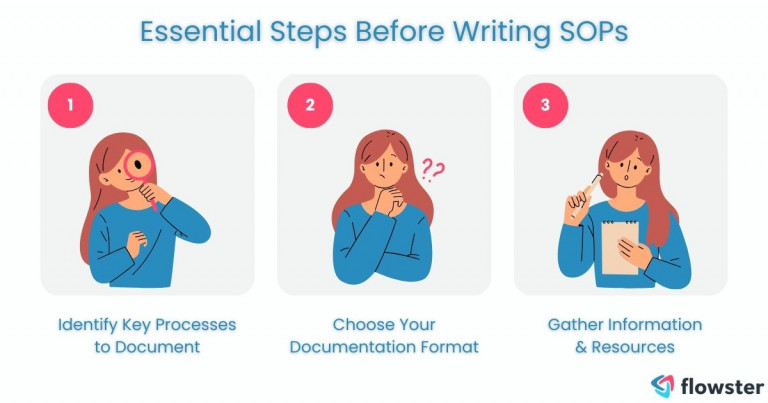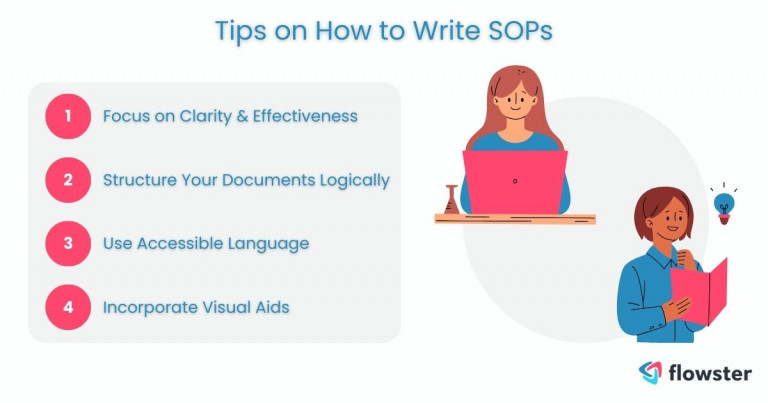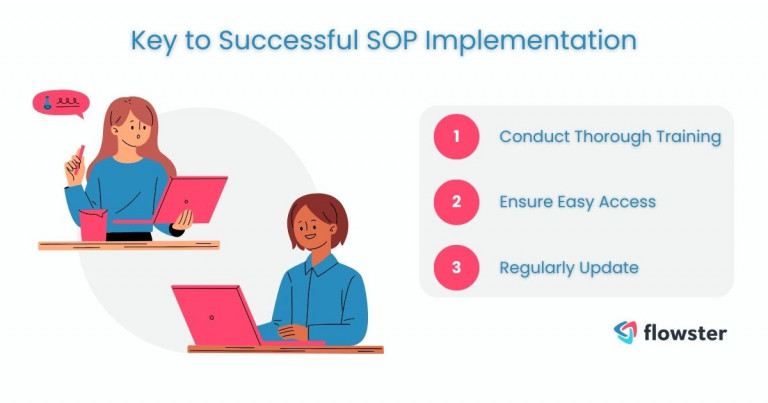In the dynamic world of small business operations, achieving efficiency and consistency is paramount to success. This is where learning how to create SOPs for small businesses comes into play, serving as the backbone for streamlining activities.
These detailed instructions are not just administrative formalities; they are crucial tools for ensuring quality, consistency, and reliability across all business operations. Crafting effective SOPs may appear challenging, but with the right approach, it can significantly elevate your business’s productivity and compliance standards.
Article Outline
Getting Started with Your Standard Operating Procedure
Embarking on the journey to create effective SOPs for your small business begins with foundational steps. Identifying critical processes, choosing the right documentation format, and gathering necessary information lay the groundwork for SOPs that streamline operations and enhance efficiency.
- Identify Key Processes to Document: Begin by pinpointing the processes that are critical to your business. Focus on step-by-step instructions for repetitive tasks, those prone to errors, and processes essential for onboarding new team members. This prioritization ensures you address the most impactful areas first, setting a strong foundation for your SOP documentation.
- Choose Your Documentation Format: SOPs can be documented in various formats, from physical binders to digital platforms. The choice depends on your business’s needs and resources. A digital approach, for instance, offers easier updates and accessibility. Consider using SOP templates to streamline the creation process.
- Gather Information and Resources: This step involves collaboration. Engage your team members who are directly involved in the existing processes. Their insights will be invaluable in ensuring your SOPs are comprehensive and accurate. Collect any existing documentation and assess tools that might aid in the SOP creation process, such as workflow diagrams or document management systems.
Leveraging SOP Templates for Efficiency
SOP templates stand as a cornerstone in streamlining SOP creation for small businesses. These templates offer a ready-made structure, covering all critical sections such as objectives, procedures, and responsibilities. Utilizing SOP templates not only saves time but also ensures uniformity across all documents, making it easier for team members to follow and understand.
For an in-depth guide on utilizing these templates to their fullest, consider visiting “SOP Templates: A Guide to Crafting Powerful Standard Operating Procedure Templates.” This resource is invaluable for small business owners looking to efficiently craft SOPs that bolster operational effectiveness.

Write Standard Operating Procedures Effectively
To ensure that your team can easily understand and implement SOPs, focus on clarity and effectiveness when creating them. Structuring your documents logically, using accessible language, and incorporating visual aids are key to creating SOPs that effectively guide your team through each process.
- Structure and Organization: A well-organized SOP document, with numbered steps and clear headings, guides users through each business process without confusion. Structure your SOPs in a way that makes logical sense and is easy to follow.
- Language and Tone: Use simple, concise language to ensure clear instructions are understandable to all employees, regardless of their experience level, who can understand and follow the SOPs. The aim is clarity and precision, avoiding any industry jargon that might obscure the instructions.
- Visual Aids: Enhance your SOPs with screenshots, diagrams, or flowcharts. Visuals can break down complex procedures into understandable parts, making the SOPs more accessible to all team members.
- Best Practices: Emphasize active voice and specific outcomes. This approach not only clarifies what needs to be done but also sets clear expectations for the results.
For further guidance on drafting SOPs tailored to the modern business landscape, explore “How to Create SOP in 2024: An Easy Step-by-Step Guide for Your Business.” This comprehensive guide offers the latest insights into creating SOPs that are both effective and aligned with current best practices.

Implementing and Maintaining SOPs for Small Businesses
The true value of SOPs is realized through their effective implementation and diligent maintenance. Ensuring easy access, conducting thorough training, and regularly updating your SOPs are crucial steps to embedding these processes into the fabric of your small business operations.
- Training and Onboarding: Effective SOP implementation is closely tied to training. Ensure that all team members are familiar with the SOPs, particularly as part of the onboarding process for new hires. This establishes a baseline for performance and expectations, in line with quality management systems.
- Accessibility and Communication: Keep SOPs easily accessible to all employees. Whether they’re stored on a shared digital platform or in a specific physical location, accessibility ensures that the SOPs are used as intended.
- Regular Review and Updates: Business processes evolve, and so should your SOPs. Schedule regular reviews to update SOPs, ensuring they reflect current best practices and operational changes. This keeps your SOPs relevant and effective.
For a detailed walkthrough on putting SOPs into action within your business, check out “How to Implement SOPs: An Easy and Effective Step-by-Step Guide.” This guide provides practical steps to ensure your SOPs are effectively integrated and maintained for optimal operational efficiency.

Overcoming Challenges on Creating and Implementing SOPs
Navigating the hurdles in SOP development and implementation is essential for success. Addressing time constraints, employee resistance, and consistency issues with strategic approaches enables small businesses to fully leverage the benefits of effective SOPs.
- Time and Resource Constraints: Small business owners often juggle multiple roles, making time a precious commodity. Prioritize the most critical SOPs first, and consider delegating tasks to leverage your team’s strengths.
- Employee Resistance: Change can be met with resistance. Address concerns by highlighting the benefits of SOPs, such as increased efficiency and reduced errors. Engaging employees in the SOP creation process can also foster buy-in.
- Maintaining Consistency: Ensure that all team members adhere to the SOPs through clear communication and accountability measures. Regular check-ins and feedback loops can help maintain consistency and identify areas for improvement.
To master the art of creating an effective workflow strategy that navigates and overcomes operational challenges, dive into “How to Make a Foolproof Workflow Strategy in 5 Easy Steps.” This resource breaks down the process into manageable steps, ensuring your strategy enhances efficiency and meets your business goals.
Transform Your Business with Flowster's AI-Driven Automation
Conclusion: Get Started on Your SOPs for Small Businesses
Creating effective SOPs is a strategic process that enhances the operational efficiency of small businesses. By following these steps, you can develop SOPs that not only streamline your internal processes but also support your team’s success.
Remember, the goal is not to document every minor task but to provide a clear framework for the most impactful processes. Start small, prioritize, and gradually build a comprehensive set of SOPs that empower your business.
Ready to take the next step? Begin today by identifying the key processes that will benefit most from standardization. Your journey towards operational excellence starts here.
Struggling to write SOPs?
Flowster allows you to easily create standard operating procedures or workflows using AI, or you can browse our library of pre-built SOP templates in the Flowster Marketplace.
Do you need assistance? Use our “Done for You” services to have our quality and improvement experts create customized workflows for you.




